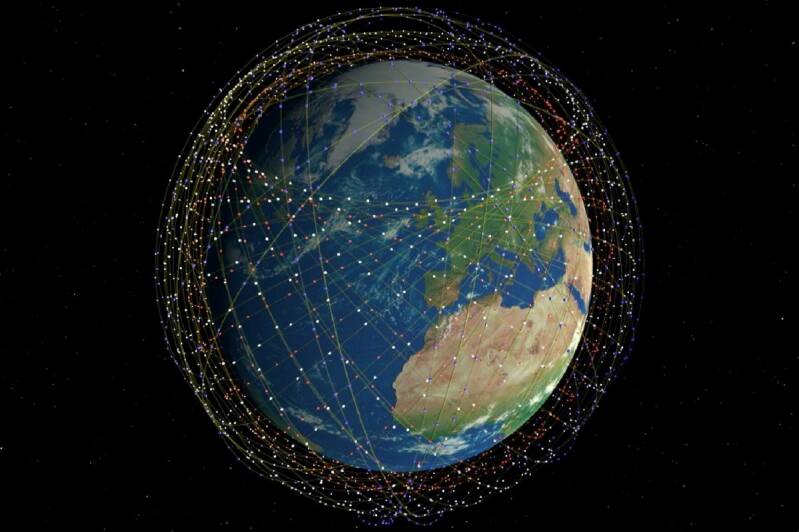SpaceX’s Starlink project, renowned for its ambitious goal of providing global satellite internet coverage, is now within reach of a transformative milestone: the completion of its initial Direct-to-Cell (D2C) constellation layer. This groundbreaking achievement, which will allow standard cellular phones to connect directly to Starlink satellites for voice, text, and limited data services, is now only five launches away.

An artist's conception of the Starlink constellation encircling the Earth. Credit: SpaceX
The completion of this initial Direct-to-Cell layer is expected to revolutionize mobile connectivity by extending cell coverage to areas that have previously lacked reliable access, such as remote regions, open waters, and underserved rural areas. Once the constellation is finalized, Starlink’s Direct-to-Cell technology will serve as an essential connectivity solution, potentially replacing traditional infrastructure needs and ensuring no gaps in service for users worldwide.
Starlink, a division of SpaceX, has been pushing the boundaries of satellite technology and low Earth orbit (LEO) deployment. The Direct-to-Cell feature is a recent extension of Starlink's mission, focusing on connecting mobile users in places where cell towers and terrestrial networks are impractical or too costly to install. By using satellites in orbit to create a blanket of connectivity, Starlink aims to integrate satellite coverage directly with cell phones on existing networks, without the need for additional hardware.
Unlike Starlink’s internet service, which requires a dedicated terminal for connection, the D2C technology will allow cellular phones to connect to the network as they would to a terrestrial cell tower. This approach is intended to fill a crucial gap, providing basic coverage to devices even in highly remote locations. Early tests and trials have demonstrated the viability of the technology, and Starlink has announced partnerships with several major telecom operators, such as T-Mobile, to enable this functionality through collaboration with existing infrastructure.
Upcoming Launches and the Path to Global Coverage
SpaceX plans to launch five more Starlink missions, each carrying additional satellites for the Direct-to-Cell constellation. These launches are expected to take place within the next few months, aiming for completion by early 2025. Each launch typically includes multiple Starlink satellites, strategically deployed to cover diverse regions of the globe, ensuring a robust and seamless network layer.
Upon completion of the initial D2C layer, Starlink will have established the foundational coverage needed to activate the service. The plan also includes adding new satellites in subsequent layers to improve capacity, expand services, and potentially provide high-speed data capabilities directly to mobile devices. Initially, however, the service will focus on SMS and voice calls, allowing basic connectivity for travelers, emergency responders, and individuals in isolated areas.
Technical and Regulatory Hurdles
The Direct-to-Cell initiative has required Starlink to work closely with regulatory bodies across various nations. Unlike standard satellite internet, the D2C service operates in frequencies typically allocated for mobile devices, necessitating adjustments in regulatory frameworks to accommodate satellite-to-cell communication. These adaptations have involved securing approval from both local and international telecommunications authorities.
In terms of technology, one of the main challenges lies in the latency and power requirements for a direct connection between cell phones and LEO satellites. Traditional mobile phones are designed to communicate with cell towers a few miles away, not satellites hundreds of miles above Earth. To bridge this gap, Starlink’s satellites have been outfitted with advanced phased array antennas and inter-satellite links, allowing them to communicate with each other and direct signals precisely to users on the ground.
The development has also benefited from SpaceX’s experience in reusability and rapid deployment. Each new batch of Starlink satellites has brought improvements, with the latest iterations optimized for both internet and Direct-to-Cell capabilities, enabling SpaceX to quickly scale the constellation without the need for ground-based cell towers.
Potential Impact and the Future of Mobile Connectivity
Once operational, Starlink's Direct-to-Cell service is expected to serve millions of users who live in or frequently travel to rural or remote areas. Emergency services could especially benefit, as search and rescue teams would have reliable communication in areas where coverage was previously unreliable or nonexistent. Additionally, the D2C network could provide a crucial redundancy layer in the event of natural disasters or network outages, where terrestrial infrastructure might be compromised.
The Direct-to-Cell capability also represents a significant competitive advantage in the satellite communications sector, where SpaceX faces rivals such as Amazon’s Project Kuiper and OneWeb. Starlink’s partnership with telecom giants, including T-Mobile, suggests that traditional mobile carriers see value in this service as a way to enhance their offerings in challenging coverage areas. As the constellation and technology mature, there are also possibilities for high-speed data capabilities, which could one day expand to support standard mobile internet use.
What’s Next for Starlink
As SpaceX nears completion of this milestone, industry watchers are eager to see how the Direct-to-Cell service will perform once fully operational. SpaceX has plans to expand beyond the initial layer with additional satellites to increase capacity, aiming to support millions of mobile devices and potentially evolving into high-speed, direct-to-phone internet access.
By the end of this year, as SpaceX carries out the final launches, users around the globe may witness a historic shift in mobile connectivity, bringing cell service to places it has never reached before. The achievement underscores Starlink’s rapid evolution and highlights SpaceX's ongoing commitment to creating a globally connected society.


Add comment
Comments
I foresee free electricity via radio wave in the near future. Great work Elon Musk and Associates!